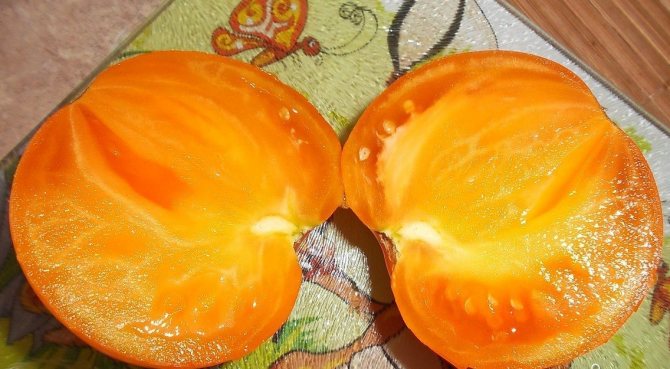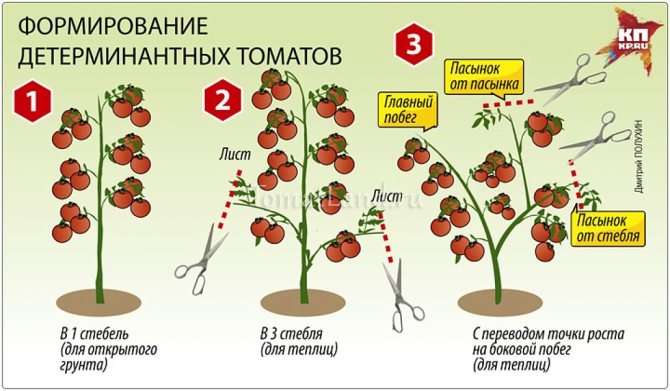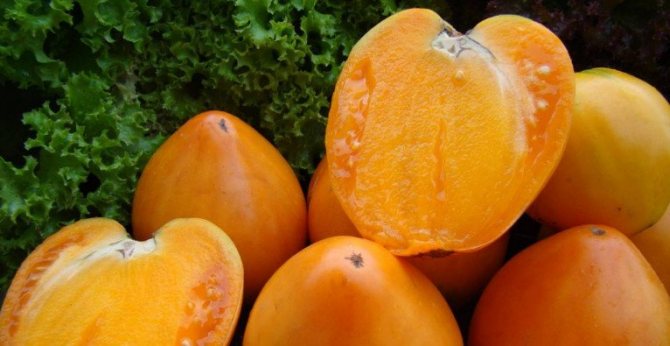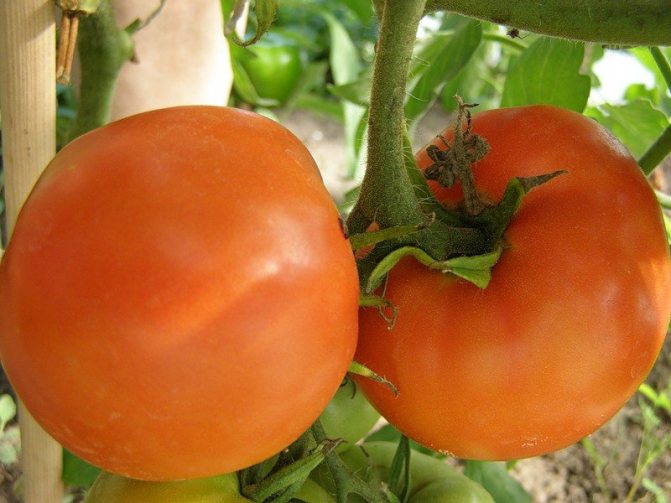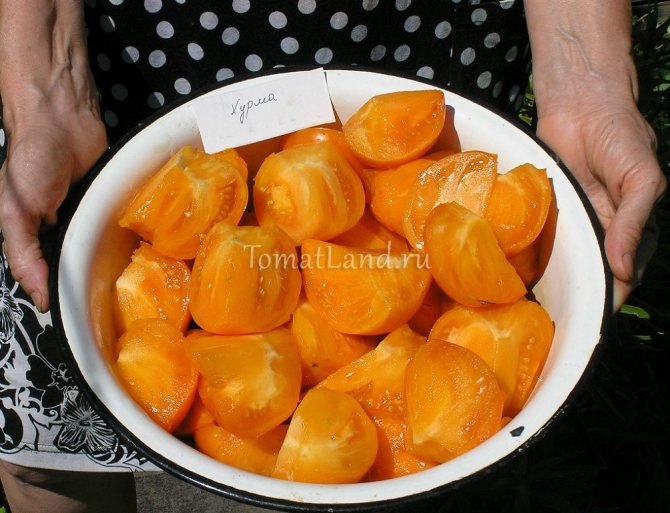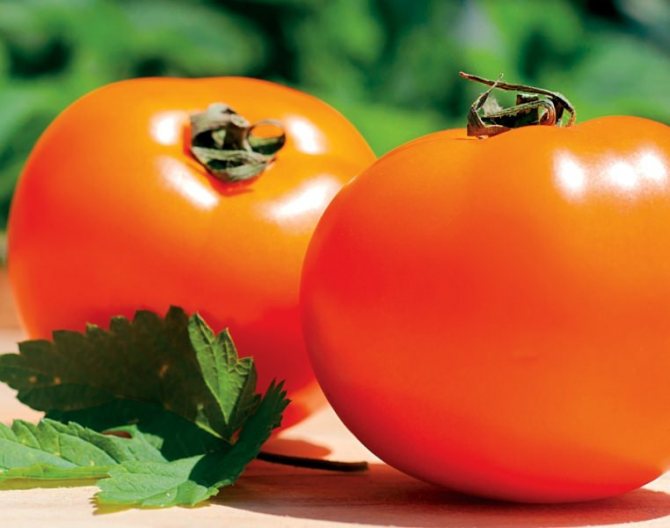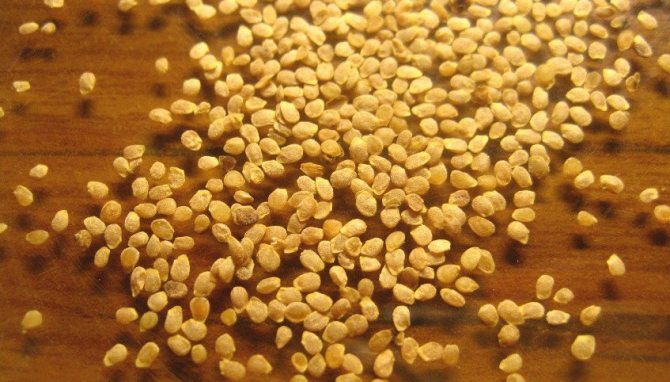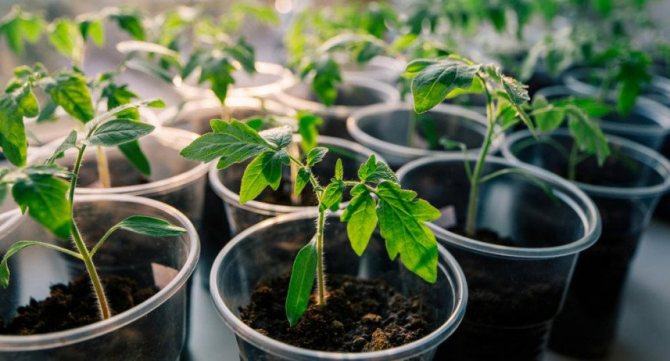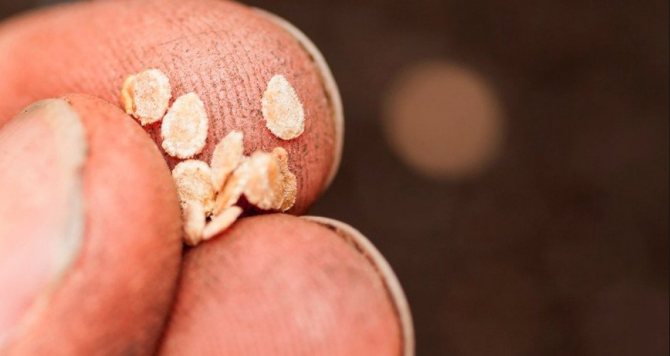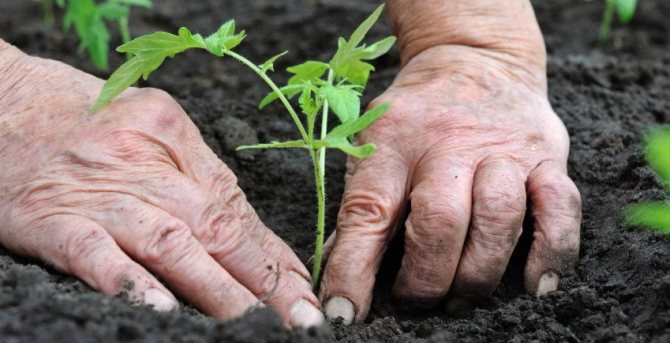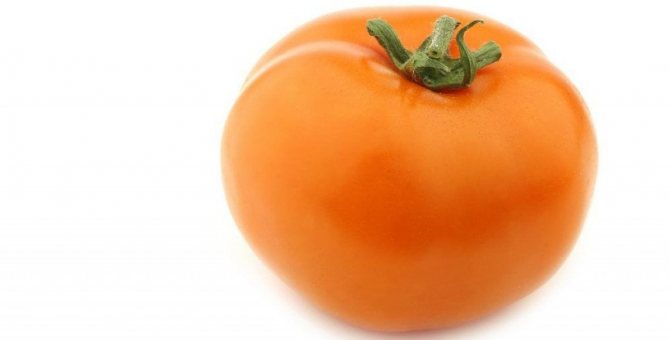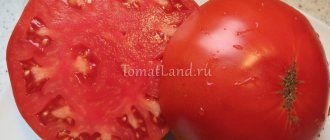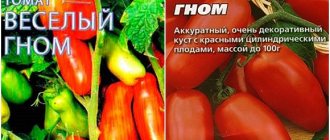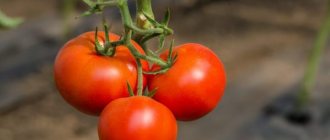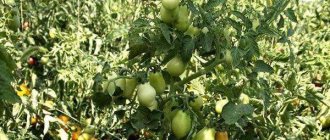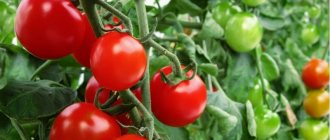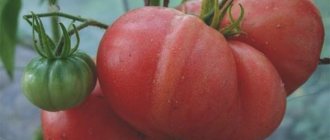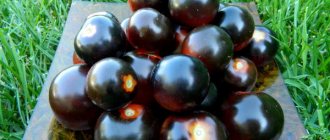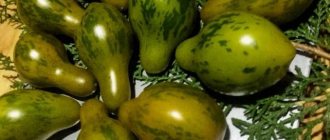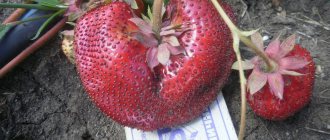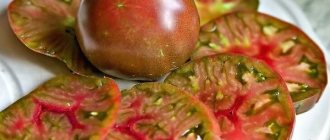Author rating
The author of the article
Yakov Pavlovich
Professor, Head of the Department of Vegetable Growing
Articles written
153
Unusual golden-orange color, attractive presentation and excellent sweet taste of Persimmon tomato make it popular among vegetable growers. It does not require a special approach and is successfully grown in different climatic zones in greenhouses and open field. Let's take a closer look: Persimmon tomato - secrets of successful cultivation, characteristics and description of the variety, interesting information for vegetable growers.
Description and characteristics of the persimmon variety
Among the tomato variety, the Persimmon variety looks dignified. A glade of such tomatoes will decorate any garden. The tomato stems are quite powerful, the leaves are large, rich green, fruit brushes are even and bright.
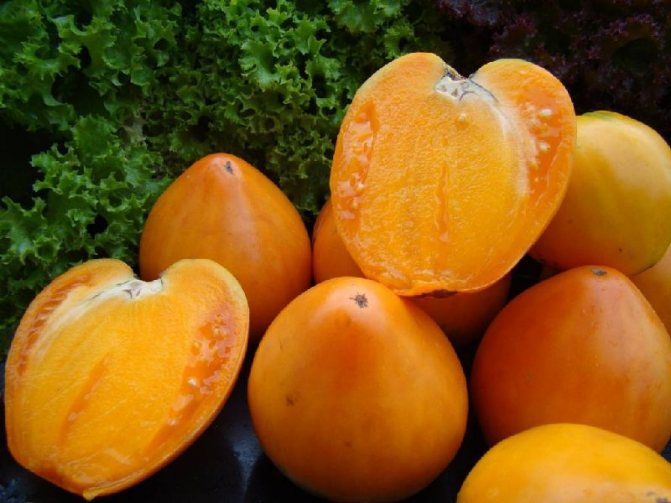
Bush
Persimmon tomato belongs to the group of determinant medium-sized plants with limited growth of the main stem. The bush reaches a height of 60–100 cm, weakly branches, but has many large, wide leaves. Lateral shoots are formed in all leaf axils.
Flowers and fruits of tomato
The inflorescences of the Persimmon variety tomato are simple and begin to form after 7–8 leaves, and then after 1–2 leaves. Fruits are large, weighing 200-350 g, flat-round in shape. Ripe tomatoes have a bright, yellow-orange color. They are very reminiscent of the fruit of the same name. The skin of the fruit is thin, firm, and resistant to cracking. It has excellent taste and high sugar content.
Yield
One bush of tomatoes Persimmon under favorable cultivation conditions gives an average of 3-4 kg of fruit. Greenhouse yields can be higher. The cultivation method, region and weather conditions of the current year have a significant impact on the productivity of plants.
Transportability
The hard peel of the Persimmon tomato variety allows the fruit to retain its appearance and marketability for a long time. Products are safely transported over long distances.
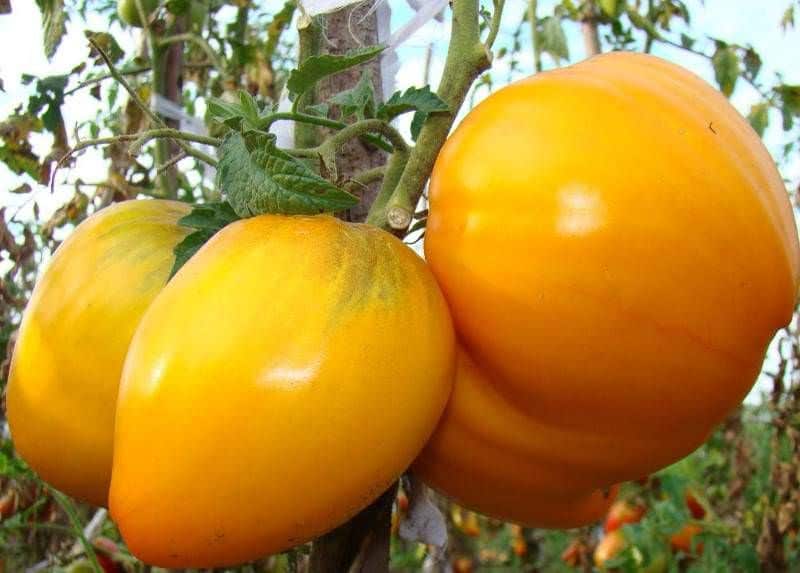

Growing geography
Persimmon tomato is zoned in most regions of the country. Depending on the region, the variety is cultivated in open ground, film shelters or greenhouses. In the middle lane and to the north, it is most advisable to grow crops in unheated protective structures.
Persimmon tomatoes on video
If you have grown persimmon tomatoes, please write whether you like them or not. What was the yield and taste of the fruit in your climatic conditions? How do you rate the resistance of this tomato to diseases and pests? Briefly write down the advantages and disadvantages of this variety in your opinion, evaluate the taste of the tomato. If possible, attach a photo of the entire bush as a whole or individual fruits grown by you to the comment. Thank you!
Your reviews about the Persimmon tomato and additions to the description will help many tomato lovers evaluate this variety objectively and decide whether it is worth planting it or not.
All varieties of tomatoes in alphabetical order, with photos, descriptions and reviews here >>>> Catalog of tomatoes
Site about tomatoes - Tomatland.
Buy tomato seeds Cornabel
Russia Gardens
Hit of the season 2020! A novelty that has shown a stunning result! High yield! Great fruit taste!
Growing features
The technology of cultivation of Persimmon tomato is traditional for determinant medium-sized varieties.
Timing
Seedlings are planted in a permanent place at the age of 55-60 days. Based on the proposed growing location, the timing of sowing seeds for seedlings is calculated. They begin to prepare seedlings for greenhouses in late February - early March, for open ground - in April. Sowing dates are adjusted taking into account the region and weather conditions.
See also Bovine Heart Tomatoes: yield and features of outdoor cultivation
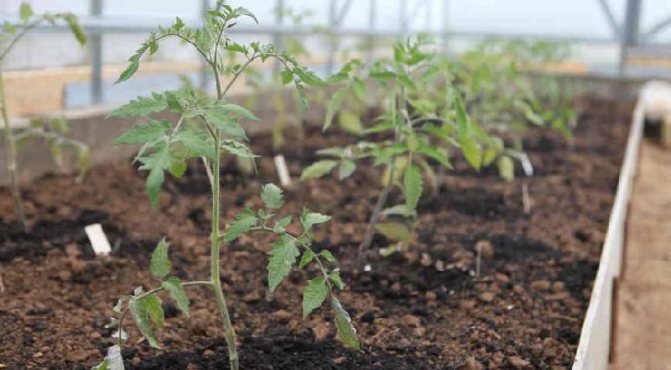

Sowing seeds
For growing seedlings, use ready-made purchased soil or garden land, previously disinfected with a solution of potassium permanganate or foundationol. In extreme cases, the soil can be warmed up in the oven for half an hour. For sowing, use shallow containers. The soil is moistened and compacted, Ready-made purchased seeds are sown to a depth of no more than 1 cm. Home-made seeds are pre-soaked in a solution of potassium permanganate for disinfection.
To prevent the seedlings from stretching out, they strictly monitor the temperature and level of lighting.
Important! To preserve moisture until germination, the container is kept covered with transparent glass or film, periodically ventilating.
In the phase of one or two true leaves, the seedlings dive into separate pots at least 8x8 cm in size.
Seedling hardening
The temperature regime when growing seedlings significantly affects its quality. For tomato Persimmon, maintain the temperature:
- before emergence +25 ºС;
- the first 7–8 days after germination + 14… + 16 ºС.
- further + 20 ... + 22 ºС.
At night, the air temperature is lowered.
Expert opinion
Stanislav Pavlovich
Gardener with 17 years of experience and our expert
Ask a Question
Two to three weeks before planting in the ground, the seedlings begin to harden. Plants are left on a balcony or veranda, where the air temperature is several degrees lower. In the future, the seedlings are taken out into the street, increasing the hardening time daily from 30 minutes to several hours. At the same time, they make sure that the plants do not get burned by the bright sun and do not suffer from the cold north wind.
Landing in the ground
The planting of seedlings into the ground begins when the air temperature is not lower than +15 ºС and the night frosts stop. Cabbage, legumes and forage crops are chosen as precursors. The ridges are prepared in two weeks, loosened, mineral fertilizers and humus are applied. The holes are dug according to the size of the root ball, moisturize well. Seedlings of persimmon tomatoes are planted at the rate of 3-4 plants per 1m2 with ribbons or staggered. The distance between plants is 45-50 cm, row spacing is 60-70 cm.
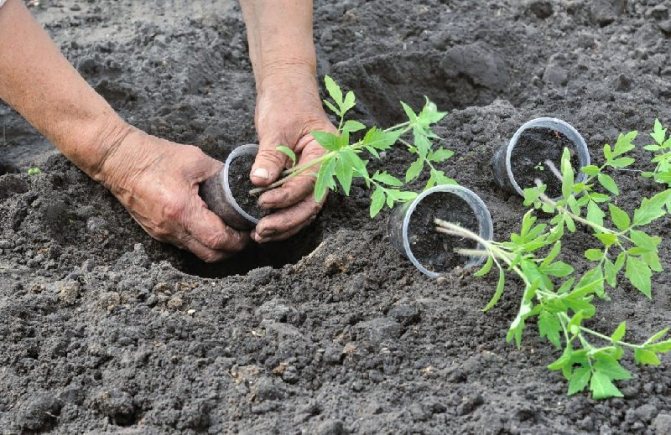

Expert opinion
Stanislav Pavlovich
Gardener with 17 years of experience and our expert
Ask a Question
Advice! Before planting, it is recommended to treat seedlings with a growth stimulator and water abundantly.
Planting and breeding
The peculiarity of the species is that the seeds are very small, moreover, there are very few of them in the vegetable. The number of chambers (sections where seeds are formed) in tomatoes is 6–7 pcs. You can buy seeds from specialized stores. But for self-collection of seed stock for the next season, you will have to work hard.
We sow the seeds
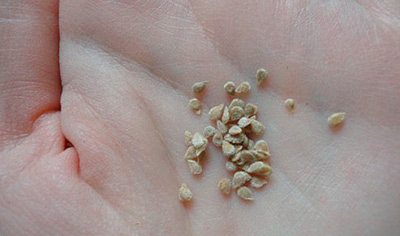

The seeds are usually planted at the end of March. They must first be treated with potassium permanganate.
Then leave for a short time in a bowl with a liquid agent that enhances the growth of future bushes.
In the meantime, evenly place high-quality and fertilized soil in the box. After that, a weak solution of "Fundazol" is introduced there.
Seed germination, according to gardeners, is from 50%. Seedlings appear in about a week after sowing.
To deepen the processed tomato seeds into the ground by 1 cm, moisten with warm water, loosen, cover with plastic or cling film and put in a sunny place. It is important to maintain a stable temperature of 23 ° C.
Please note! Lighting should be optimal.If necessary, you can install an additional light (for example, a table lamp) so that the seedlings do not stretch too far up.
Transplanting
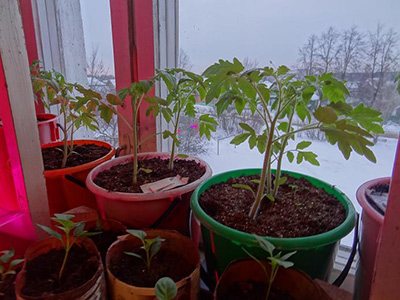

When the first shoots appear, the film cover must be removed. After a week after planting the seeds, feed the seedlings with minerals.
Soon, two leaves will appear at the sprout that has broken through the ground. Now it is dived (transplanted) with single stalks into a separate bowl.
In a month, when the last frost has passed, the seedlings will be ready for transplanting into the ground. Depending on the particular region, this usually falls on the end of April or May.
By this time, the height of the bushes usually reaches 15 cm. But until this moment, throughout April, the sprouts are hardened: they are taken out into the open air for 3-5 minutes in a place with sufficient sunlight. Gradually you need to increase the time the seedlings stay outside.
Note! The hardening procedure is carried out after the ground part of the plant has dried after watering.
With successful hardening, the seedlings can be transferred to shallow pits. Do not forget to add fertilizer first. Next, carefully cover the roots with soil, lightly tamp everything.
Watering the seedlings at the root. To do this, use extremely clean warm water. After each bathing procedure, you need to loosen the soil.
To achieve an excellent harvest, it is important to spray the crop with an antimicrobial agent every 14 days, which will help protect it from diseases and parasites. In addition, the plant needs mineral and organic fertilizers.
According to the ripening period, this vegetable belongs to medium ripeness tomatoes: from sowing to harvest, it takes 105-112 days... Fruit ripening depends on many factors, these are:
- air temperature;
- soil quality;
- watering frequency;
- absence of diseases and parasites.
Advice! Those who do not want to prepare seedlings on their own can purchase ready-made material in the spring. With this option, it is possible to choose the bushes ideal for planting.
Tomato care recommendations
Agrotechnical measures for the care of Persimmon tomatoes include cleaning weeds, loosening the soil, forming a bush, watering and feeding.
Watering and feeding
In the open field, the frequency of watering depends on the weather conditions and is carried out as the soil dries up. The first time is watered a week after planting, if the hole and seedlings were sufficiently moistened. Top dressing is combined with watering. During the growing season, it is enough to feed the Persimmon tomato 2-3 times:
- 2-3 weeks after disembarkation - with mullein or nitrophoska solution;
- after another 10-14 days - phosphorus-potassium fertilizers.
See also The best varieties of tomatoes for open ground and greenhouses in Belarus
Shaping and garter
In order to prevent the persimmon tomato bush from thickening, its formation is carried out in one or two, less often in three stems. For this, in addition to the main stem, one or two healthy stepsons are left in the lower part of the plant, from which additional stems grow. The rest of the stepsons up to 5 cm in size from the axils of the leaves are broken out or cut out with a knife. The stump left will restrain the re-growth of the stepson. Passionking is carried out at least 1 time per week so that the processes do not overgrow. Persimmon tomatoes need a garter to a stable support or trellis.
Expert opinion
Stanislav Pavlovich
Gardener with 17 years of experience and our expert
Ask a Question
Advice! To improve the ripening of the fruit, it is necessary to remove 2-3 leaves from each stem every week.
Growing varieties in a greenhouse
Low greenhouses are suitable for persimmon tomato, since plant growth is limited. No more than 3–3.5 plants are planted per 1m2 in protected ground. Form the tomato into one or two stems. To prolong fruiting, the formation technique is used with the transfer of the growth point to the lateral shoot.
Main characteristics
- A relatively new variety of determinant type, created by domestic breeders.
- The variety got its name due to the similarity of the fruit to the tropical fruit - persimmon.
- The variety is mid-season, with low bushes 76-80 cm (in a greenhouse 90-100 cm).
- A bush with strong foliage, capable of forming fruits weighing up to 500-550 g.
- Fruits are flat-oval in shape and turn orange when fully ripe.
- The pulp of the fruit contains a significant amount of carotene.
- The variety has strong stems and large leaves.
- The variety can be affected by various fungal diseases.
- The grown harvest is used for the production of tomato juice and various sauces, conservation.
- With proper cultivation techniques from a bush, you can pick up up to 2-2.4 kg. ripe fruits.
Disease and pest control
In order to prevent the development of diseases, it is necessary to carry out preventive measures:
- keep the site, structures and equipment in order and cleanliness;
- timely remove weeds, damaged organs and tissues of tomato;
- provide optimal humidity;
- to process tomato seedlings with bromine, preparations "Glyokladin", "Gamair", "Alirin", "Fitosporin", "Oxyhom" and other copper-containing preparations;
- observe crop rotation and sow adjacent crops that repel pests.
Expert opinion
Stanislav Pavlovich
Gardener with 17 years of experience and our expert
Ask a Question
Helpful! In order to prevent late blight, use a tincture of chopped garlic (40 g per 10 liters of water) or milk, whey (2 liters per 10 liters of water). Tomato plants are sprayed with an interval of 10-14 days.
How to pinch tomatoes
As everyone already knows, pinching is used in almost all types of tomato cultivation. It involves the removal of stepchildren, that is, the shoots that appeared on the bushes after the formation of the stem. Beginners are not very familiar with this procedure and sometimes they simply do not understand what needs to be removed, so we want to tell you in detail about this and teach you how to properly carry out the process of pinching determinant plants.
So, the first stepson usually appears under the first flower brush, it is very strong and takes a lot of energy from the plant, it is not advisable to remove it if you form a plant in two stems. Everything that is above can be cut off, but it is better to leave spare processes, which in which case can grow and bear fruit. Experienced gardeners recommend checking the bushes for new shoots weekly.
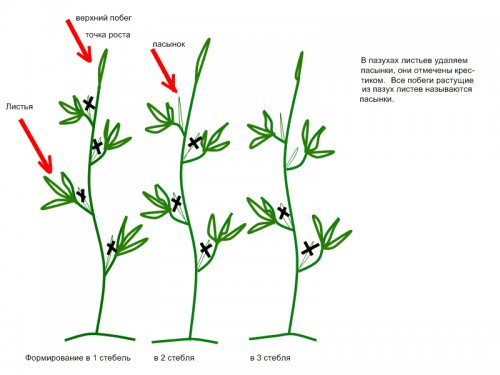

If you are a beginner gardener and still have a burning desire to plant this particular variety, do not be discouraged if you do not succeed the first time. It is better to write down all the mistakes in your notebook and try to grow this tomato again next summer, taking into account all your previous mistakes. We are confident one day you will enjoy a rich harvest of sunny colors.
Tatyana
I have been growing the Persimmon tomato variety for about three years. The first experience was unsuccessful, I spent so much time and effort on seedlings, and on transplanting them into open ground, and after a while all the bushes died from a heavy downpour, which lasted two days. Now I use only greenhouse conditions. The harvest is always tasty, large, sometimes it is possible to pick small fruits in an unripe form and put them in a box to saturate the color, and then roll up jars of whole-fruited tomatoes. For the winter, I canned juice and adjika from these tomatoes, and in the summer I add them to all sorts of salads, and as a cut, this vegetable is quickly eaten. I recommend everyone to try tomato persimmon and appreciate its unique taste.
Svetlana
Last year I grew persimmon and will never buy the seeds of this tomato again. She looked after the bushes well, but when the fruits ripened, I saw small tomatoes that looked like cherry tomatoes, and there were very few of them. Variety disappointed and sorry for the time spent.I came to the conclusion that it is better to grow what has already grown in my garden, so at least there is some kind of stability and reliability, and the new varieties are probably not for me.
Oksana
And I like "Persimmon". I learned about this variety from my mother-in-law, who spends time in the garden for days and constantly grows something new. So, once we came to visit her, and she put a plate of persimmon on the table. At first I thought it was a fruit and was surprised, they say, where did she find such fruit in the summer? To which the mother-in-law laughed and said that it was a tomato. I tasted them and was amazed, it is so sweet that it really looks a little like persimmon, and the aroma did not have a tomato smell at all. Now such an orange miracle is growing in my country house.
How to grow seedlings
It is extremely important to grow healthy and strong seedlings, since the future health and productivity of the plant depends on it. Consider the features of growing at the initial stage.
Seed preparation
To make the seeds germinate faster, they are soaked. Before planting, fill the seeds with warm water and leave for 1-2 hours. Seeds that float are not suitable for planting. The rest can be safely used.
Advice... It is useful to add a little potassium permanganate to the water when soaking. This will disinfect the seeds and avoid the development of diseases in the future.
Promotes an increase in resistance to various diseases, soaking in growth stimulants (for example, "Baikal", "Epin Extra", "Zircon").
Capacity and soil
Tomatoes prefer slightly acidic, closer to neutral soil 5-6 PH.
For planting, use ready-made universal substrates or prepare the mixture yourself: mix sand, peat and earth in equal proportions. The mixture prepared independently for disinfection is calcined in the oven and spilled with a solution of potassium permanganate.
In the process of growing seedlings, you will need two types of containers:
- a low container or box for planting seeds for germination. For these purposes, ordinary food containers or a wooden box covered with plastic are suitable. Do not forget to provide drainage holes;
- individual containers for growing plants after picking. In hardware stores, there is a large assortment of ready-made growing containers. Or, use food grade plastic cups and other containers that are convenient for you.
Sowing
Sowing seeds is carried out 50-60 days before the intended planting of the plant in the ground or greenhouse. The seeds are placed in moist soil to a depth of 1-1.5 cm. To reduce moisture evaporation, the container is covered with a film.
After the first seeds germinate, the film is removed. The optimum temperature for keeping sprouts varies in the range of 20-24 degrees.
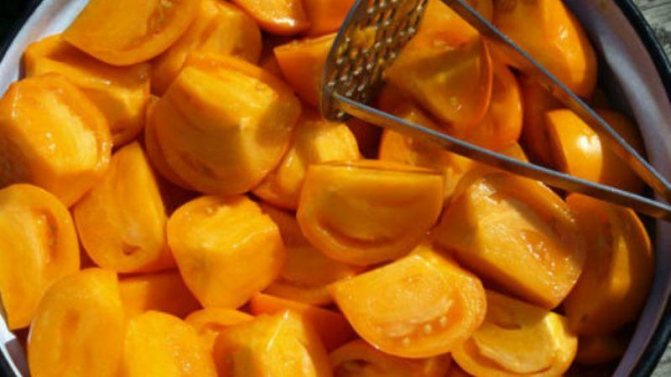

Growing and care
After opening 1-2 leaves on the sprouts (after about 15-20 days), the seedlings dive. The seedling is buried in the ground up to the cotyledon leaves. A few days after transplanting, when the plant slightly adapts to new conditions, the night temperature is gradually reduced to +18 degrees.
Water the seedlings in moderation, in the morning, with lukewarm water. An excess of moisture is dangerous for the plant by the development of diseases.
Once every 2-3 weeks, top dressing is applied based on potassium and phosphorus.
Description of fruits
The fruits of the Persimmon variety are very tasty and most often are slightly better than its counterparts. This is due to the fact that the pulp is tender and juicy, and also has a wonderful aroma. The peel of tomatoes is quite dense, but at the same time thin and practically not felt when eaten. If you cut a tomato, then there is a small number of chambers, about 7 pieces. Each chamber is filled with sap and semen.
When the variety reaches full ripeness, it becomes a vigorous orange color, as well as as sweet as possible. If the harvest date is wrong, as if sooner or later, the fruits will be sour, as either not ripe or overripe.Therefore, keeping track of the harvest time is very important.
The fruit itself has a round shape, sometimes it can be slightly elongated, even in its appearance it very much resembles a persimmon. This variety belongs to a large-fruited species, each fruit can reach up to 450 grams in weight. If tomatoes are grown in a more favorable room, for example, in a greenhouse, then the weight of the fruits can increase to 550-600 grams.
Note: If you notice a green spot in the place where the stalk is attached, this means that this tomato is not ripe. After the complete disappearance of the stain, it is safe to say about 100% ripening.
Tomatoes of this variety are also very useful, as they contain many useful substances, for example, carotene, lycopene and a small amount of organic acid.
Very often Persimmon is used in cooking, as it has an excellent taste. It is used both fresh and in the form of preserves and sauces.
Conservation
Many people wonder if it is possible to preserve a persimmon tomato? In fact, this tomato variety is often used for canning. Based on the many reviews of gardeners, it can be understood that vegetables can be preserved whole (without cutting), since the Persimmon tomato has a rather dense peel, the preservation is excellent.
Also, on the basis of this tomato, canned salads are prepared for the winter, which are perfectly stored and have excellent taste due to the unique hybrid variety of tomatoes.
Advantages and disadvantages
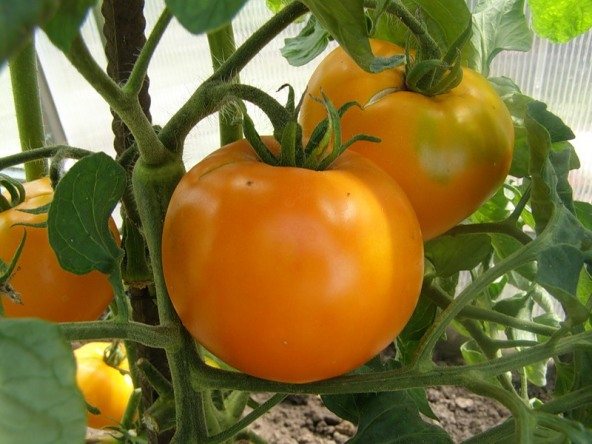

The main advantage of the Persimmon variety is its large fruit size, individual fruits reach 500 grams. The tomatoes are beautiful and juicy. 2-4 kilograms of fruit are removed from one bush. The fruits contain a large amount of carotene and practically no organic acids. These tomatoes are ideal for diet food.
The variety is grown in hotbeds, greenhouses, open ground. Seed germination is 90 percent. Such indicators attract many gardeners.
The collection of tomatoes can be carried out in an unripe form, the fruits ripen outside the bush without losing their qualities. Tomatoes are easy to transport, do not lose their appearance and are well stored.
When grown in unheated greenhouses and greenhouses, the yield is better than when grown outdoors.
The disadvantages include:
- The variety is picky about care. It is not resistant to diseases typical of this culture, especially late blight.
- Bushes need to be tied up, as large fruits are pulled to the ground and this leads to a break in the plant. The tomato does not like heat and is picky about watering.
Other interesting varieties:
Testimonials
Most gardeners who are engaged in the cultivation of varietal plants characterize the Persimmon variety on the positive side. High yield and special taste of the fruit make the crop attractive to many gardeners.
Those who planted Persimmon tomatoes note that it is better to grow this variety in a greenhouse. This makes it possible to create the most favorable climatic conditions for plants, under which tomatoes will bear fruit for the longest possible time.
Not everyone likes the taste of these vegetables, which is characterized by the lack of sourness characteristic of tomatoes. The appearance of tomatoes leaves few people indifferent. Large bright yellow vegetables contain a huge amount of nutrients.
Some gardeners are confused by the tendency of the varietal plant to characteristic fungal diseases. Competent and timely care for it, which includes, among other things, the preventive treatment of the culture, will not allow the disease to injure the culture.
The numerous advantages of the vegetable, which are described by those who have already planted this crop, contribute to the fact that the persimmon tomato variety is used for growing by many gardeners.High-quality plant care will provide an opportunity to get a rich harvest of excellent vitamin vegetables.

